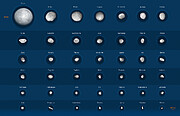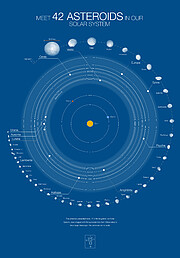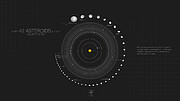Comunicato Stampa
Ecco a voi il 42: l'ESO fotografa alcuni dei più grandi asteroidi del Sistema Solare
12 Ottobre 2021

Utilizzando il VLT (Very Large Telescope) dell'ESO, l'Osservatorio Europeo Australe in Cile, alcuni astronomi hanno ripreso 42 dei più grandi oggetti nella fascia degli asteroidi, situata tra Marte e Giove. Mai prima d'ora era stato ripreso in modo così nitido un gruppo così grande di asteroidi. Le osservazioni rivelano un'ampia gamma di forme peculiari, da quelle sferiche a quelle a forma di osso, e stanno aiutando gli astronomi a rintracciare le origini degli asteroidi nel Sistema Solare.
Le immagini dettagliate di questi 42 oggetti sono un balzo in avanti nell'esplorazione degli asteroidi, reso possibile grazie ai telescopi da terra, e contribuiscono a rispondere alla domanda fondamentale sulla vita, l'Universo e tutto quanto [1].
"Solo tre grandi asteroidi della fascia principale, Cerere, Vesta e Lutetia, sono stati ripresi finora con un alto livello di dettaglio, poiché sono stati visitati dalle missioni spaziali Dawn e Rosetta, rispettivamente della NASA e dell'Agenzia Spaziale Europea (ESA)", spiega Pierre Vernazza, del Laboratoire d'Astrophysique de Marseille in Francia, che ha guidato lo studio sugli asteroidi pubblicato oggi su Astronomy & Astrophysics. "Le nostre osservazioni dell'ESO hanno fornito immagini nitide per molti altri oggetti, 42 in totale".
Il numero, precedentemente esiguo, di osservazioni dettagliate di asteroidi significava che, fino a oggi, caratteristiche chiave come la loro forma tridimensioale o la loro densità erano in gran parte sconosciute. Tra il 2017 e il 2019, Vernazza e il suo gruppo hanno cercato di colmare questa lacuna conducendo un'indagine approfondita dei principali corpi della fascia degli asteroidi.
La maggior parte dei 42 oggetti nel campione ha dimensioni maggiori di 100 km; in particolare, sono stati ripresi quasi tutti, 20 su 23, gli asteroidi della fascia più grandi di 200 chilometri. I due oggetti più grandi che il gruppo ha sondato sono Cerere e Vesta, che hanno diametri di circa 940 e 520 chilometri, mentre i due asteroidi più piccoli sono Urania e Ausonia, ciascuno di soli circa 90 chilometri.
Ricostruendo le forme degli oggetti, il gruppo di ricercatori si è reso conto che gli asteroidi osservati sono generalmente divisi in due famiglie. Alcuni sono quasi perfettamente sferici, come Igea e Cerere, mentre altri hanno una forma più particolare, "allungata": la regina incontrastata è l'asteroide Cleopatra, a forma di "osso per cani".
Combinando la forma degli asteroidi con le informazioni sulla loro massa, gli astronomi hanno scoperto che la densità cambia significativamente nel campione. I quattro asteroidi meno densi tra quelli studiati, tra cui Lamberta e Sylvia, hanno densità di circa 1,3 grammi per centimetro cubo, simile alla densità del carbone. I più densi, Psyche e Kalliope, hanno densità rispettivamente di 3,9 e 4,4 grammi per centimetro cubo, superiori alla densità del diamante (3,5 grammi per centimetro cubo).
Questa grande differenza di densità suggerisce che la composizione degli asteroidi vari in modo significativo, fornendo agli astronomi importanti indizi sulla loro origine. “Le nostre osservazioni forniscono un forte supporto per una sostanziale migrazione di questi corpi sin dalla loro formazione. In breve, una tale varietà nella composizione può essere compresa solo se i corpi hanno avuto origine in regioni distinte del Sistema Solare", spiega Josef Hanuš dell'Università Carlo di Praga, Repubblica Ceca, uno degli autori dello studio. In particolare, i risultati favoriscono la teoria secondo cui gli asteroidi meno densi si sono formati nelle regioni remote oltre l'orbita di Nettuno e sono successivamente migrati nella posizione attuale.
Questi risultati sono stati resi possibili grazie alla sensibilità dello strumento SPHERE (Spectro-Polarimetric High-contrast Exoplanet REsearch) montato sul VLT dell'ESO [2]. "Con le ampliate capacità di SPHERE, e viste le poche informazioni sulla forma dei più grandi asteroidi della fascia principale note finora, siamo stati in grado di fare progressi sostanziali in questo campo", afferma il coautore Laurent Jorda, pure al Laboratoire d'Astrophysique de Marseille.
Gli astronomi saranno in grado di visualizzare un maggior numero di asteroidi nei minimi dettagli con il futuro ELT, l'Extremely Large Telescope dell'ESO, attualmente in costruzione in Cile, che inizierà le operazioni entro la fine di questo decennio. "Le osservazioni degli asteroidi della fascia principale con ELT ci consentiranno di studiare oggetti con diametri fino a 35-80 chilometri, a seconda della loro posizione nella fascia, e crateri di dimensioni fino a circa 10-25 chilometri", afferma Vernazza. “Avere uno strumento simile a SPHERE installato sull'ELT ci permetterebbe persino di riprendere un campione simile di oggetti nella lontana fascia di Kuiper. Ciò significa che saremo in grado di caratterizzare da terra la storia geologica di un campione molto più ampio di piccoli corpi».
Note
[1] In The Hitchhiker's Guide to the Galaxy (Guida galattica_per_gli_autostoppisti in italiano) di Douglas Adams, il numero 42 è la risposta alla "domanda fondamentale sulla vita, l'universo e tutto quanto". Oggi, 12 ottobre 2021, ricorre il 42° anniversario della pubblicazione del libro.
[2] Tutte le osservazioni sono state condotte con lo Zurich IMaging POLarimeter (ZIMPOL), un sottosistema di polarimetri per produrre immagini dello strumento SPHERE che opera a lunghezze d'onda visibili.
Ulteriori Informazioni
Questo risultato è presentato in un articolo pubblicato dalla rivista Astronomy & Astrophysics (https://www.aanda.org/10.1051/0004-6361/202141781).
L'equipe è composta da P. Vernazza (Aix Marseille University, CNRS, CNES, Laboratoire d’Astrophysique de Marseille, Francia [LAM]), M. Ferrais (LAM), L. Jorda (LAM), J. Hanuš (Institute of Astronomy, Faculty of Mathematics and Physics, Charles University, Prague, Repubblica Ceca [CU]), B. Carry (Université Côte d’Azur, Observatoire de la Côte d’Azur, CNRS, Laboratoire Lagrange, Francia [OCA]), M. Marsset (Department of Earth, Atmospheric and Planetary Sciences, MIT, Cambridge, USA [MIT]), M. Brož (CU), R. Fetick (French Areospace Lab [ONERA] e LAM), M. Viikinkoski (Mathematics & Statistics, Tampere University, Finlandia [TU]), F. Marchis (LAM e SETI Institute, Carl Sagan Center, Mountain View, USA), F. Vachier (Institut de mécanique céleste et de calcul des éphémérides, Observatoire de Paris, PSL Research University, CNRS, Sorbonne Universités, UPMC University Paris 06 e Université de Lille, Francia [IMCCE]), A. Drouard (LAM), T. Fusco (French Areospace Lab [ONERA] e LAM), M. Birlan (IMCCE e Astronomical Institute of Romanian Academy, Bucharest, Romania [AIRA]), E. Podlewska-Gaca (Faculty of Physics, Astronomical Observatory Institute, Adam Mickiewicz University, Poznan, Polonia [UAM]), N. Rambaux (IMCCE), M. Neveu (University of Maryland College Park, NASA Goddard Space Flight Center, US [UMD]), P. Bartczak (UAM), G. Dudziński (UAM), E. Jehin (Space sciences, Technologies and Astrophysics Research Institute, Université de Liège, Belgio [STAR]), P. Beck (Institut de Planetologie et d’Astrophysique de Grenoble, UGA-CNRS, Francia [OSUG]), J. Berthier (IMCCE), J. Castillo-Rogez (Jet Propulsion Laboratory, California Institute of Technology, Pasadena, USA [JPL]), F. Cipriani (European Space Agency, ESTEC - Scientific Support Office, Noordwijk, Paesi Bassi [ESTEC]), F. Colas (IMCCE), C. Dumas (Thirty Meter Telescope, Pasadena, USA [TMT]), J. Ďurech (CU), J. Grice (Laboratoire Atmosphères, Milieux et Observations Spatiales, CNRS e Université de Versailles Saint-Quentin-en-Yvelines, Guyancourt, Francia [UVSQ] e School of Physical Sciences, The Open University, Milton Keynes, Regno Unito [OU]), M. Kaasalainen (TU), A. Kryszczynska (UAM), P. Lamy (Departamento de Fisica, Ingeniería de Sistemas y Teoría de la Señal, Universidad de Alicante, Alicante, Spagna), H. Le Coroller (LAM), A. Marciniak (UAM), T. Michalowski (UAM), P. Michel (OCA), T. Santana-Ros (Institut de Ciències del Cosmos, Universitat de Barcelona, Spagna e European Southern Observatory, Santiago, Cile), P. Tanga (OCA), A. Vigan (LAM), O. Witasse (ESTEC), B. Yang (European Southern Observatory, Santiago, Cile), P. Antonini (Observatoire des Hauts Pays, Bédoin, Francia), M. Audejean (Observatoire de Chinon, Chinon, Francia), P. Aurard (AMU, Observatoire de Haute Provence, Institut Pythéas, Saint-Michel l’Observatoire, Francia [OHP]), R. Behrend (Geneva Observatory, Sauverny, Svizzera e High Energy Physics and Astrophysics Laboratory, Cadi Ayyad University, Marrakech, Marocco [UCA]), Z. Benkhaldoun (UCA), J. M. Bosch (B74, Avinguda de Catalunya 34, 25354 Santa Maria de Montmagastrell (Tarrega), Spagna), A. Chapman (Cruz del Sur Observatory, San Justo city, Buenos Aires, Argentina), L. Dalmon (OHP), S. Fauvaud (Observatoire du Bois de Bardon, Taponnat, Francia e Association T60, Observatoire Midi-Pyrénées, Toulouse, Francia), Hiroko Hamanowa (Hong Kong Space Museum, Tsimshatsui, Hong Kong, PR China [HKSM]), Hiromi Hamanowa (HKSM), J. His (OHP), A. Jones (I64, SL6 1XE, Maidenhead, UK), D-H. Kim (Korea Astronomy and Space Science Institute, Daejeon, Corea [KASI] e Chungbuk National University, Chungdae-ro, Seowon-gu, Cheongju-si, Chungcheongbuk-do, Corea), M-J. Kim (KASI), J. Krajewski (Faculty of Physics, Astronomical Observatory Institute, Adam Mickiewicz University, Poznań, Polonia), O. Labrevoir (OHP), A. Leroy (Observatoire OPERA, Saint Palais, Francia [OPERA] e Uranoscope, Gretz-Armainvilliers, Francia), F. Livet (Institut d’Astrophysique de Paris, Paris, Francia, UMR 7095 CNRS et Sorbonne Universités), D. Molina (Anunaki Observatory, Calle de los Llanos, Manzanares el Real, Spagna), R. Montaigut (Club d’Astronomie de Lyon Ampere, Vaulx-en-Velin, Francia and OPERA), J. Oey (Kingsgrove, NSW, Australia), N. Payre (OHP), V. Reddy (Planetary Science Institute, Tucson, USA), P. Sabin (OHP), A. G. Sanchez (Rio Cofio Observatory, Robledo de Chavela, Spagna), e L. Socha (Cicha 43, 44-144 Nieborowice, Polonia).
L'ESO (European Southern Observatory, o Osservatorio Australe Europeo) è la principale organizzazione intergovernativa di Astronomia in Europa e di gran lunga l'osservatorio astronomico più produttivo al mondo. È sostenuto da 16 paesi: Austria, Belgio, Danimarca, Finlandia, Francia, Germania, Irlanda, Italia, Paesi Bassi, Polonia, Portogallo, Regno Unito, Repubblica Ceca, Spagna, Svezia, e Svizzera, oltre al paese che ospita l'ESO, il Cile e l'Australia come partner strategico. L'ESO svolge un ambizioso programma che si concentra sulla progettazione, costruzione e gestione di potenti strumenti astronomici da terra che consentano agli astronomi di realizzare importanti scoperte scientifiche. L'ESO ha anche un ruolo di punta nel promuovere e organizzare la cooperazione nella ricerca astronomica. L'ESO gestisce tre siti osservativi unici al mondo in Cile: La Silla, Paranal e Chajnantor. Sul Paranal, l'ESO gestisce il Very Large Telescope, osservatorio astronomico d'avanguardia nella banda visibile e due telescopi per survey. VISTA, il più grande telescopio per survey al mondo, lavora nella banda infrarossa mentre il VST (VLT Survey Telescope) è il più grande telescopio progettato appositamente per produrre survey del cielo in luce visibile. L'ESO è il partner principale di APEX e di ALMA, il più grande progetto astronomico esistente, sulla piana di Chajnantor. E sul Cerro Armazones, vicino al Paranal, l'ESO sta costruendo l'Extremely Large Telescope o ELT (significa Telescopio Estremamente Grande), un telescopio da 39 metri che diventerà "il più grande occhio del mondo rivolto al cielo".
La traduzione dall'inglese dei comunicati stampa dell'ESO è un servizio dalla Rete di Divulgazione Scientifica dell'ESO (ESON: ESO Science Outreach Network) composta da ricercatori e divulgatori scientifici da tutti gli Stati Membri dell'ESO e altri paesi. Il nodo italiano della rete ESON è gestito da Anna Wolter.
Links
- Articolo scientifico
- Fotografie del VLT
- Ulteriori informazioni sull'ELT (Extremely Large Telescope) dell'ESO
- Per i giornalisti: iscrivetevi per ricevere i nostri comunicati sotto embargo nella vostra lingua
- Per i ricercatori: avete una storia da raccontare? Inviateci il vostro articolo scientifico
Contatti
Pierre Vernazza
Laboratoire d’Astrophysique de Marseille
Marseille, France
Tel.: +33 4 91 05 59 11
E-mail: pierre.vernazza@lam.fr
Josef Hanuš
Charles University
Prague, Czechia
E-mail: josef.hanus@mff.cuni.cz
Laurent Jorda
Laboratoire d’Astrophysique de Marseille
Marseille, France
Tel.: +33 4 91 05 69 06
E-mail: laurent.jorda@lam.fr
Bárbara Ferreira
ESO Media Manager
Garching bei München, Germany
Tel.: +49 89 3200 6670
Cell.: +49 151 241 664 00
E-mail: press@eso.org
Anna Wolter (press contact Italia)
Rete di divulgazione scientifica dell'ESO
e INAF-Osservatorio Astronomico di Brera
Milano, Italy
Tel.: +39 02 72320321
E-mail: eson-italy@eso.org
Sul Comunicato Stampa
| Comunicato Stampa N": | eso2114it |
| Tipo: | Solar System : Interplanetary Body : Asteroid |
| Facility: | Very Large Telescope |
| Instruments: | SPHERE |
| Science data: | 2021A&A...654A..56V |
Our use of Cookies
We use cookies that are essential for accessing our websites and using our services. We also use cookies to analyse, measure and improve our websites’ performance, to enable content sharing via social media and to display media content hosted on third-party platforms.
ESO Cookies Policy
The European Organisation for Astronomical Research in the Southern Hemisphere (ESO) is the pre-eminent intergovernmental science and technology organisation in astronomy. It carries out an ambitious programme focused on the design, construction and operation of powerful ground-based observing facilities for astronomy.
This Cookies Policy is intended to provide clarity by outlining the cookies used on the ESO public websites, their functions, the options you have for controlling them, and the ways you can contact us for additional details.
What are cookies?
Cookies are small pieces of data stored on your device by websites you visit. They serve various purposes, such as remembering login credentials and preferences and enhance your browsing experience.
Categories of cookies we use
Essential cookies (always active): These cookies are strictly necessary for the proper functioning of our website. Without these cookies, the website cannot operate correctly, and certain services, such as logging in or accessing secure areas, may not be available; because they are essential for the website’s operation, they cannot be disabled.
Functional Cookies: These cookies enhance your browsing experience by enabling additional features and personalization, such as remembering your preferences and settings. While not strictly necessary for the website to function, they improve usability and convenience; these cookies are only placed if you provide your consent.
Analytics cookies: These cookies collect information about how visitors interact with our website, such as which pages are visited most often and how users navigate the site. This data helps us improve website performance, optimize content, and enhance the user experience; these cookies are only placed if you provide your consent. We use the following analytics cookies.
Matomo Cookies:
This website uses Matomo (formerly Piwik), an open source software which enables the statistical analysis of website visits. Matomo uses cookies (text files) which are saved on your computer and which allow us to analyze how you use our website. The website user information generated by the cookies will only be saved on the servers of our IT Department. We use this information to analyze www.eso.org visits and to prepare reports on website activities. These data will not be disclosed to third parties.
On behalf of ESO, Matomo will use this information for the purpose of evaluating your use of the website, compiling reports on website activity and providing other services relating to website activity and internet usage.
Matomo cookies settings:
Additional Third-party cookies on ESO websites: some of our pages display content from external providers, e.g. YouTube.
Such third-party services are outside of ESO control and may, at any time, change their terms of service, use of cookies, etc.
YouTube: Some videos on the ESO website are embedded from ESO’s official YouTube channel. We have enabled YouTube’s privacy-enhanced mode, meaning that no cookies are set unless the user actively clicks on the video to play it. Additionally, in this mode, YouTube does not store any personally identifiable cookie data for embedded video playbacks. For more details, please refer to YouTube’s embedding videos information page.
Cookies can also be classified based on the following elements.
Regarding the domain, there are:
- First-party cookies, set by the website you are currently visiting. They are stored by the same domain that you are browsing and are used to enhance your experience on that site;
- Third-party cookies, set by a domain other than the one you are currently visiting.
As for their duration, cookies can be:
- Browser-session cookies, which are deleted when the user closes the browser;
- Stored cookies, which stay on the user's device for a predetermined period of time.
How to manage cookies
Cookie settings: You can modify your cookie choices for the ESO webpages at any time by clicking on the link Cookie settings at the bottom of any page.
In your browser: If you wish to delete cookies or instruct your browser to delete or block cookies by default, please visit the help pages of your browser:
Please be aware that if you delete or decline cookies, certain functionalities of our website may be not be available and your browsing experience may be affected.
You can set most browsers to prevent any cookies being placed on your device, but you may then have to manually adjust some preferences every time you visit a site/page. And some services and functionalities may not work properly at all (e.g. profile logging-in, shop check out).
Updates to the ESO Cookies Policy
The ESO Cookies Policy may be subject to future updates, which will be made available on this page.
Additional information
For any queries related to cookies, please contact: pdprATesoDOTorg.
As ESO public webpages are managed by our Department of Communication, your questions will be dealt with the support of the said Department.









